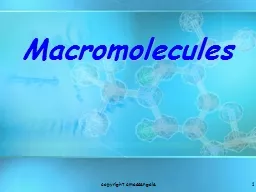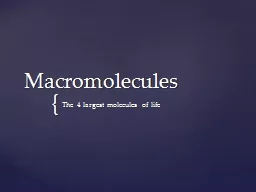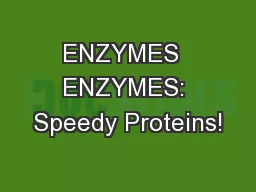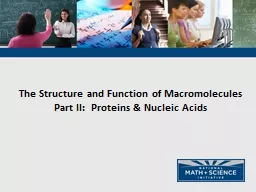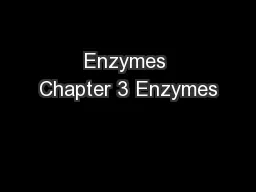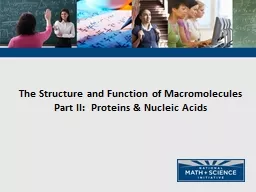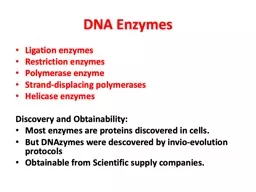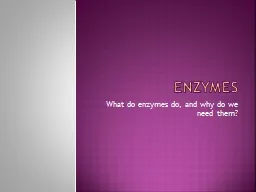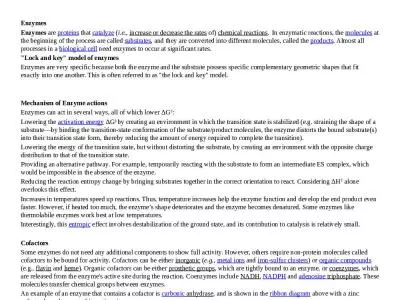PPT-Keystone Review Day 3 Water, macromolecules, structure/function, enzymes
Author : debby-jeon | Published Date : 2018-09-29
Structure and function are closely related Change the structure cannot function Examples Red blood cells sickle cell anemia round shape allows them to fit through
Presentation Embed Code
Download Presentation
Download Presentation The PPT/PDF document "Keystone Review Day 3 Water, macromolecu..." is the property of its rightful owner. Permission is granted to download and print the materials on this website for personal, non-commercial use only, and to display it on your personal computer provided you do not modify the materials and that you retain all copyright notices contained in the materials. By downloading content from our website, you accept the terms of this agreement.
Keystone Review Day 3 Water, macromolecules, structure/function, enzymes: Transcript
Structure and function are closely related Change the structure cannot function Examples Red blood cells sickle cell anemia round shape allows them to fit through blood vessels Muscle cells . Chapter 2: Section 2.5. 1. Objectives. SWBAT explain the effect of a catalyst on activation energy. . SWBAT describe how enzymes regulate chemical reactions. . and maintain homeostasis.. 2. Starter: How can this be possible. copyright cmassengale. 2. Organic Compounds. Compounds. that contain . CARBON. are called . organic. .. Macromolecules. are large . organic molecules. .. copyright cmassengale. 3. Carbon (C). Carbon. Employee Welcome Packet. A NEW EMPLOYEE’S GUIDE TO KEYSTONE. 1. Welcome to Keystone Resort!. We are excited to have you as part . of the Keystone team. . To make . your transition easier. , we have . and PSSA Tests. October 30, 2017. Dr. Rebekah Baum-Leaman, PA Department of Education. Lisa . Hampe. , . PA Department of Education. Lynda Lupp, PaTTAN – East. Diane Simaska, PA Department of Education. The ability to biosynthesize the 4 major macromolecules. i.e. you can create by yourself- the 4 . major molecules . of life. What is life again?. The reason these are necessary for life is because they are the basic ingredients for the macromolecules:. IMPORTANCE. OF ENZYMES. Enzymes are biological catalysts that:. . I. ncrease. . reaction rates . by lowering the amount of energy needed for the reaction to occur. 100-1000x . faster. !!!. Activation Energy. Part II: Proteins & Nucleic Acids. The FOUR Classes of Large Biomolecules. All living things are made up of four classes of large biological molecules: . Carbohydrates . Lipids. Protein. N. ucleic Acids. Community Demographics. Population = 337 (. 2010). 0-4 years 5.5%. 5-17 years 16.5%. 18-64 years 65%. 65 years 13%. 8.4% population increase from 2000. 2 Million visitors per year to nearby Mt. Rushmore – travel through/visit Keystone. Part 1. . Chapter 3. Learning outcomes. You should be able to:. explain how enzymes work. describe and explain the factors that affect. enzyme activity. use V. max. and K. m. to compare the affinity of different enzymes for their substrates. The Structure and Function of Macromolecules Part II: Proteins & Nucleic Acids The FOUR Classes of Large Biomolecules All living things are made up of four classes of large biological molecules: Restriction enzymes. Polymerase enzyme. Strand-displacing polymerases. Helicase enzymes. Discovery and Obtainability:. Most enzymes are proteins discovered in cells.. But . DNAzymes. were . descovered. Enzymes. Back when we discussed proteins, we learned that one critical function of protein was to speed up chemical reactions.. Enzymes. are the proteins that increase the rate of chemical reactions. Multicore Applications. Literature Number: SPRPXXX. 1. Agenda. Interrupt Scheme . Example 1: SPI Transmit Interrupt. Example 2: HyperLink Interrupt. ARM Interrupt Scheme. 2. Interrupt Scheme. KeyStone Interrupts. that . catalyze. (. i.e.. , . increase or decrease the rates. of) . chemical reactions. .. . In enzymatic reactions, the . molecules. at the beginning of the process are called . substrates. , and they are converted into different molecules, called the .
Download Document
Here is the link to download the presentation.
"Keystone Review Day 3 Water, macromolecules, structure/function, enzymes"The content belongs to its owner. You may download and print it for personal use, without modification, and keep all copyright notices. By downloading, you agree to these terms.
Related Documents


